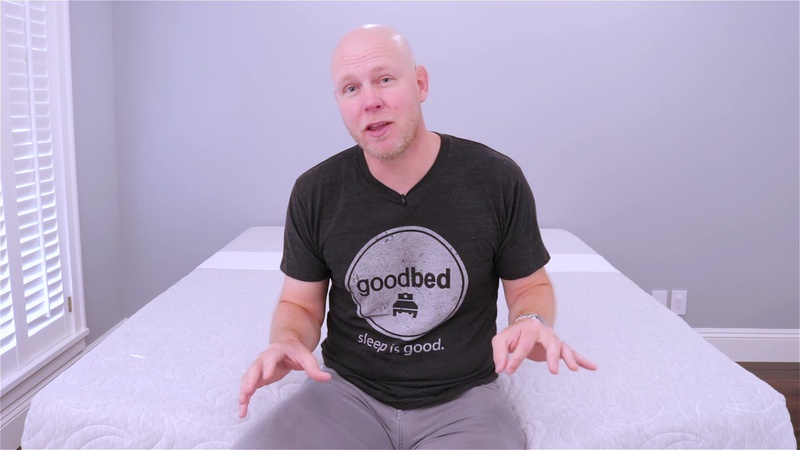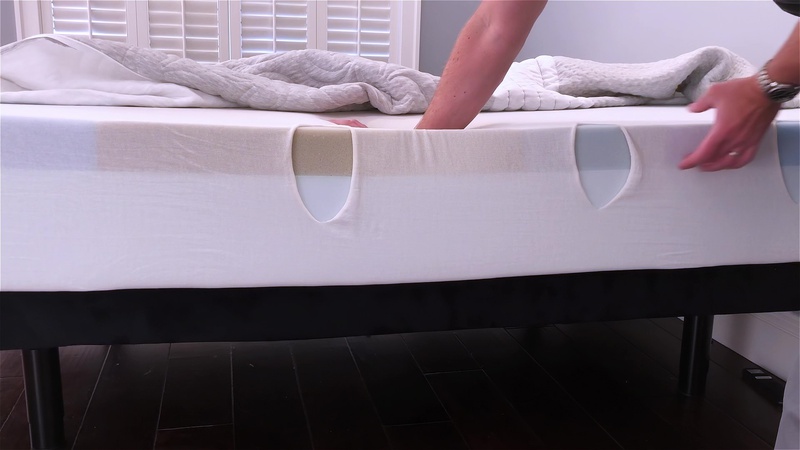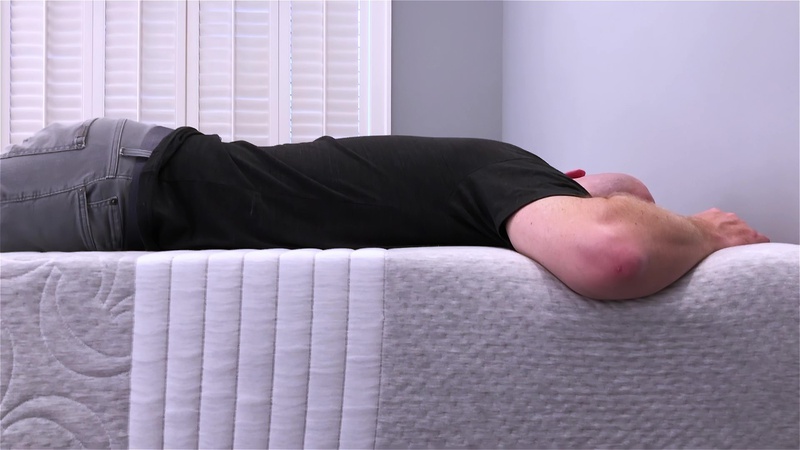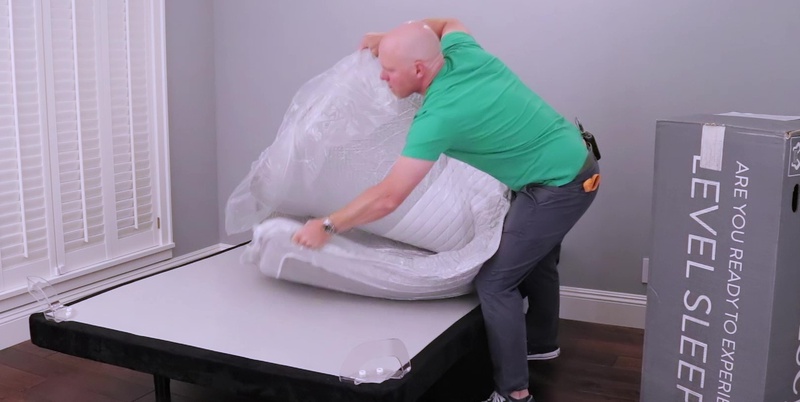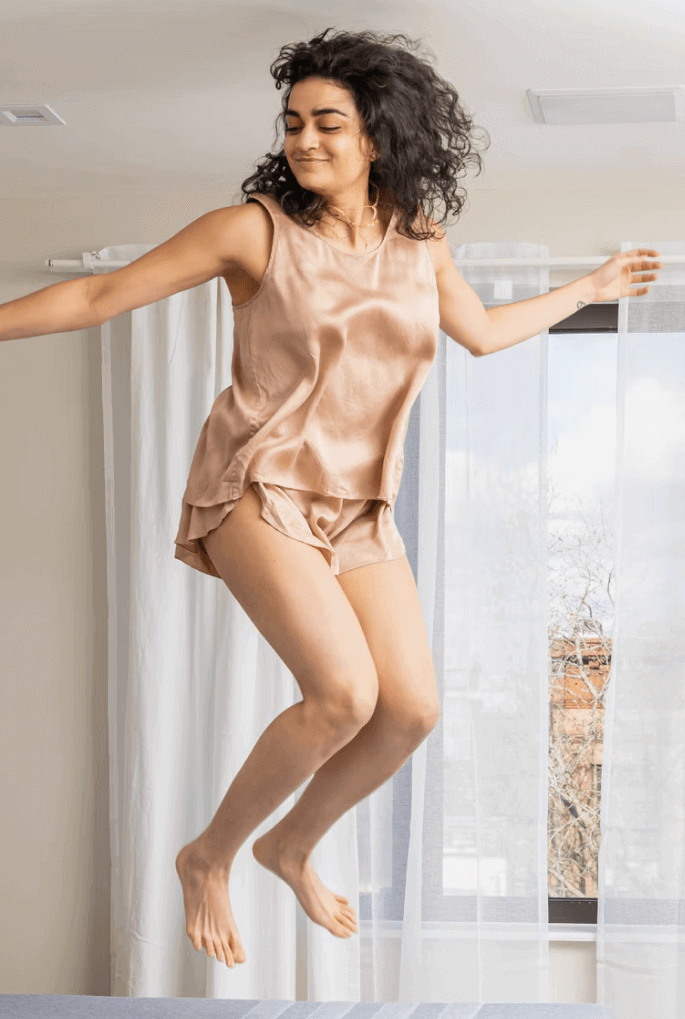Cover
The mattress is wrapped in a cover that has a jersey knit-like feel. It has three different decorative patterns to indicate the lumbar support zone, and the head/foot.
Comfort & Feel
There are three aspects that make up our assessment of comfort and feel. We call these "preference-based characteristics" because no rating here is better or worse – rather, the attributes that are most desirable to you will be determined solely by your personal preferences. We apply the same classification standards to each mattress so you can more easily compare apples to apples.
Softness ( what’s this )
Keep in mind that what mattress companies call “firm” or “soft” is a purely a preference. All mattresses should be supportive and promote healthy spinal alignment. Whether a mattress is fluffy and squishy (what mattress companies call soft or plush), or less so (what companies call firm), is purely down to your personal needs and preferences.
We classify the Level Sleep as a Medium overall, but there's significant variation between the different zones of this mattress. The head and foot of the bed are very soft, the hip area is a medium soft, and the lumbar support zone is quite firm. So even though we'll call the entire bed a "Medium" be aware of those zone differences.
Not sure what softness is best for you? Take our Mattress Match Quiz and find out.
| Softness Level (1=Least Soft, 9=Most Soft) |
5 | Medium |
Cushioning Depth ( what’s this )
This refers to how deeply you sink into the mattress or feel cradled or hugged, versus a feeling of floating on top of the bed.
We'd call cushioning depth average, but again, there are differences depending on where you are on the bed. You'll sink more deeply at the head and foot, and significantly less so in the middle. But this isn't a memory foam bed, nor is the foam particularly conforming, so you don't feel you are sinking into the bed more than with other mattresses.
| Cushioning Depth (1=Shallowest, 9=Deepest) |
5 | Average |

Responsiveness ( what’s this )
Responsiveness refers to how quickly a mattress recovers its shape after being compressed. When you press your hand into the mattress, for instance, then remove it, does it take several seconds for the mattress to return to flat, or does it recover immediately?
Responsiveness also translates to bounce, which we test in a few days. Surface bounce and mid-level bounce (tested with a 16-pound bowling ball) matter most for sex; some people prefer some bounce to their mattress and other couples don't. Lastly, our tester drops his whole weight on to the bed to analyze deep bounce. The Level Sleep had no appreciable bounce in any of these tests, unsurprising for an all-foam mattress.
| Memory Feel (1=Least, 9=Most) |
1 | None |
| Bounce (1=Least, 9=Most) |
4 | Very little bounce |
Back Support & Pressure Relief
The two things that you should always be sure to get from your mattress are spinal alignment (commonly thought of as "back support") and pressure relief. Unfortunately, no mattress will deliver these two things equally well for all sleepers. In particular, spinal alignment and pressure relief capabilities will vary across sleepers with different weights, body shapes, and sleep positions. To help you determine how this mattress will perform for you, we break down our spinal alignment and pressure relief assessments by sleeper type.
The big selling feature of the Level Sleep is, of course, its zoned support and extra lumbar support. So we especially looked at that in our tests.
Spinal Alignment
The key to good back support is maintaining proper spinal alignment while you sleep. This means that the mattress should hold your spine in roughly the same position it's in when you're standing. The ability of a given mattress to do this will generally depend on your weight, sleep position, and body shape.
Here is how we break down the spinal alignment of the Level Sleep mattress:
| Weight | Range | Back Sleepers | Side Sleepers | Stomach Sleepers |
| Lighter | <150 lb | 9 | 6 | 8 |
| Average | 150 to 200 lb | 9 | 6 | 8 |
| Above Average | 200 to 250 lb | 9 | 7 | 8 |
| Heavier | >250 lb | 9 | 7 | 7 |
Back Sleepers:
Our tester really felt the benefit of the lumbar-support zone while on his back. It had a pronounced and positive effect. And we found that people of a wide weight range would have a similar experience.
Not everyone may want or need this much assertive lumbar support, but our tester enjoyed it very much. It's also worth noting that the lumbar support is in a specific area on one end of the mattress; if you turn the bed 180 degrees (as is recommended to even out the wear), you won't get the same lumbar experience.
Side Sleepers:
For side sleeping, our tester did not get any benefit from the lumbar zone. In fact, he felt some unwelcome pressure on his rib cage while on his side, which could potentially effect spinal alignment. The unique feature of the Level Sleep bed is in lumbar support for back sleepers. For side sleepers, it isn't helpful and could possibly be a detriment, and either way, you would not be taking advantage of the feature you've paid for.
Stomach Sleepers:
Achieving good spinal alignment for stomach sleepers can often be trickier as the hips can tend to sink down too far with some mattresses, but our tester felt well supported in this position. While the lumbar support area isn't designed for stomach sleepers, we did not feel it was a hindrance. We might have concerns those significantly heavier than our tester, who might find hips sinking too deeply to maintain spinal alignment (to be fair, we would have this concern with the majority of all-foam beds).
Pressure Relief
When a mattress pushes back against your body with too much force in a concentrated area, the result can be pain, soreness, loss of circulation, excessive tossing, and other problems. In general, such "pressure points" are of greatest concern for side sleepers, since that's the position in which your body's weight is distributed over the smallest surface area. To find the right mattress for your needs, keep in mind that the pressure-relieving capabilities of any given mattress will vary depending on the sleeper. Factors like your weight and body shape (e.g., broader shoulders and/or hips) will determine how far you sink into the mattress, and the pressure relief offered by that mattress will vary widely at different depths.
Here's how we sized up the pressure relief of the Level Sleep mattress:
| Weight | Range | Typical Curves | Extra Curvy |
| Lighter | <150 lb | 9 | 8 |
| Average | 150 to 200 lb | 8 | 8 |
| Above Average | 200 to 250 lb | 8 | 8 |
| Heavier | >250 lb | 8 | 8 |
This mattress, with its lumbar support zone, isn't designed with side sleepers in mind (side sleeping is where pressure relief is most a priority). That said, our tester did feel good pressure relief from the soft foam above the lumbar zone area, with his shoulder sinking nicely into the mattress, and the soft foam provided good cushioning.
As discussed above, we found spinal alignment the be more the issue when side sleeping than pressure relief.
Other Features
Beyond the preference-based characteristics of comfort and feel, and the body matching for spinal alignment and pressure relief, a mattress will have a number of other attributes that can make it a better or worse choice for you. We call these "priority-based characteristics" because they are areas in which a mattress can be better or worse, but that will have differing amounts of importance to each sleeper. So, determining how much importance to give to these features will be entirely a matter of your own personal priorities. As always, we apply the same ratings standards to each mattress so you can more easily compare apples to apples.
Motion Isolation ( what’s this )
With a bowling pin standing upright on the Level Sleep bed, we tested motion isolation by dropping a 16-lb. bowling ball on it, as well as the whole weight of our 200-lb. tester.
In the bowling ball test, the bowling pin wiggled a tiny bit but didn’t fall. And when our tester dropped his entire weight onto the Level Sleep bed, the pin barely moved.
We felt that this mattress would be an excellent choice for couples who don’t want to feel their partner getting in and out of bed.
| Motion Isolation Rating |
9 /10 | Excellent |
Temperature ( what’s this )
| Stay's 'Cool' Rating |
5/10 |
Okay |
Edge Support ( what’s this )
Foam mattresses aren’t typically very supportive along the very edge of the mattress—important if you like to sit on the edge of the bed, or if you tend to sleep along the edge. With the Level Sleep mattress, we were pleasantly surprised.
Edge support while sitting depends on which part of the bed you're sitting on; on the lumbar area, you'll sink in less than on the head and foot areas. Even so, our tester did not feel unstable.
When laying on the edge of the bed, he felt stable, and this bed performed better than other foam mattresses.
| Edge Support Rating |
7/10 |
Good |

Ease of Repositioning ( what’s this )
If you tend to move and change positions a lot over the course of a night, ease of repositioning will be a priority for you. Our tester did experience any issues changing positions.
| Repositioning Rating |
8 /10 | Very good |
Green Features ( what’s this )
For mattress shoppers concerned with the use of natural materials, sustainable manufacturing practices or the like, we offer our subjective evaluation of any efforts taken by the company to make the mattress more green, healthy, or safe.
In the case of the Level Sleep mattress, the company makes no claims about the use of natural materials: Its foams are petroleum-based, held together by chemical glues.
All of the foams used are certified to the CertiPUR-US standard, which verifies that a material has low VOC off-gassing as well as a lack of chemicals and other substances regulated by the CPSC. This is a certification we see obtained by nearly all mainstream mattress manufacturers today.
We did give the Level Sleep mattress an informal 'sniff test' upon unpacking and found it to have a lower than average amount of that new-mattress smell.
| Green Rating |
4/10 | Fair |
Adjustable Base Compatibility ( what’s this )
We also tested the Level Sleep mattress atop an adjustable base. Here, we are looking for how well the mattress conforms, and for any concerning behaviors that might lead us to believe that the bed could be damaged. We did not note any potentially damaging issues with the bed, however, it did not conform very well to our adjustable base. When our tester got out of the bed in its fully articulated position, the center of the mattress popped back up -- it wants to be flat. We would expect this would improve somewhat after a break-in period, but out of the box, conformance was not ideal.
| Adjustable Base Use Rating |
7 /10 | Good |

Price, Value & Longevity
How Much Does a Level Sleep Mattress Cost?
Prices shown are list prices. Remember that GoodBed keeps our site current with the best available discounts on all online mattresses, many of which are exclusive discounts for our readers. This is an exclusive discount for our readers, and also provides GoodBed with a small referral fee from Level Sleep that supports our work at no cost to you.
What Are You Getting?
The Level Sleep is a 10-inch mattress made of polyurethane foam with zoned support in the mattress's top layer of foam. With firmer support in the lumbar area, and corresponding softer support in the hip area, and the softest foam at the head and foot, the bed promises particularly good support for back sleepers.
How Long Will the Level Sleep Mattress Last?
When it comes to estimating the comfort lifespan of a mattress, we tend to use foam density as our best, albeit imperfect, predictor of how long a foam will retain its shape and resiliency. The support foam at the bottom of the mattress is standard 1.8 lb. polyurethane foam, which generally has a good track record for longevity. If we have any concerns, it’s the top layer of Energex foam, a proprietary foam that doesn't have the same track record. And at 2.0 - 2.2-lb. density, this is a lower density comfort foam than we often see. However, Level Sleep's 365-day trial can be reassurance against issues over the first year of ownership.
Overall Value
| Value Rating | 6 /10 | Pretty good |









































 Comparison
Comparison

